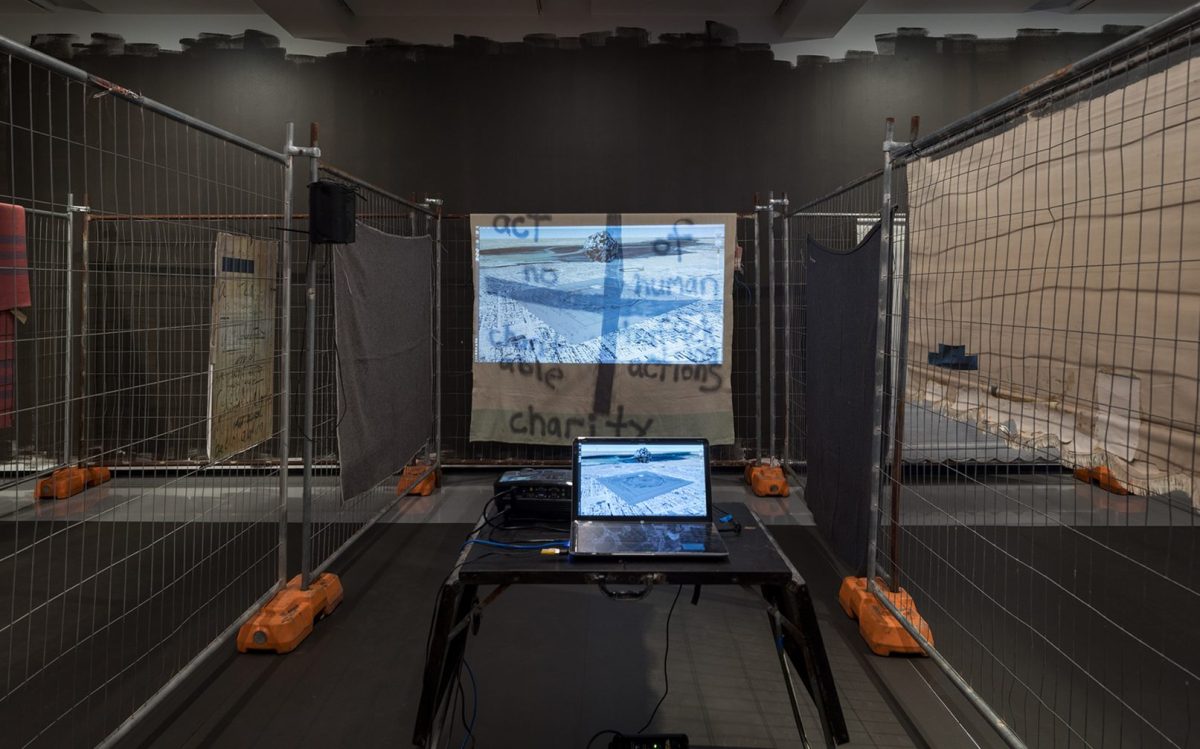While scrolling through Instagram to seek refuge from the sense of despair and loss felt post the 2024 US election results, I came across a photo of Barbara Kruger’s Untitled (Questions) (1989-90). Bold white phrases bring tension into a seemingly mundane parking lot – “WHO IS BEYOND THE LAW? WHO IS BOUGHT AND SOLD? WHO IS FREE TO CHOOSE? WHO DOES TIME? WHO FOLLOWS ORDERS? WHO SALUTES THE LONGEST? WHO PRAYS LOUDEST? WHO DIES FIRST? WHO LAUGHS LAST?”.
I think about a person as power, as the manipulator of truth, and about the vast, mind-boggling injustice between people – a species so casually encapsulated in one word and yet so fundamentally disparate.
It felt like the right time to begin this review of epochal, Aotearoa New Zealand collective et al.’s recent exhibition at the Monash University Museum of Art (MUMA), a show that I’ve been sitting on for the past few weeks trying to digest and make sense of.
This review needs to be prefaced by stating that the significance of the work of et al. from a sociopolitical and epistemological standpoint can be evaluated independent of the exhibition; that is, the form of its presentation. Many will recognise that the work of et al. is bigger than an institution – any institution really – but in saying that, MUMA has fulfilled its role in capturing some of its essence.
Walking into epochal is deeply unsettling, with its rows of rusty metal fencing barricading the gallery and thick strokes of dark grey paint consuming MUMA’s pristine white walls. Towels, blankets, map, posters and written material are scattered like tired justice fighters, starved and worn for the greater good (what and for who?).
Death and violence is palpable, despite the lack of explicit imagery. In one corner, a white bedsheet banner displays ‘AUM’ in block letters of fluorescent pink. If one hadn’t known about the Japanese terrorist cult Aum Shinrikyo, it may have been mistaken as a cheerleader banner for the local high school’s basketball team.
Sound is another foreboding element in epochal, from the skin-prickling drone of sub-oceanic sound recordings of a French nuclear bomb being detonated in autonomous purification unit (APU) (2004-24) to trans_cryption (2011-24) between the darkened gallery corridors.
Curatorially speaking, the alternating display of two videos in MUMA’s entrance gallery – one running over an hour and the other for 15 minutes – means that visitors will encounter either one or the other, rather than both. n-f-w (2024), an abbreviation of “no f**king way” will be the dominant experience for most, and rightly so, for its overwhelming presentation of structurally embedded violence towards women.
epochal is not an easy show in any sense, and neither is it addressed to the general audience who may expect a leisurely afternoon of art viewing. But for students, artists and academics on campus, it’s an invaluable case study that warrants repeated, in-depth visits.
Read: Exhibition review: Tony Clark: Unsculpted, Buxton Contemporary
Coincidently (or not), a quote from Donald Trump in his March 2024 campaign speech is included in the accompanying monograph, juxtaposed with Michel Foucault in Truth and Power (1977). While Foucault discusses a “‘general politics of truth” harboured in each society, which includes considerations around “the status of those who are charged with saying what counts as true”, Trump proclaimed, “… I am your warrior. I am your justice… I am your retribution”.
In the contributing essay, Dr Gwynneth Porter continues, “Over the almost 25 years of et al.’s urgent questioning of the individual’s relationship to total power and individual freedom, we have watched some of the most extraordinary global events occur. Not global warfare or nuclear testing, but the recording and prevalence of belief and fundamentalism, totalitarianism and liberty – of the state and individual alike – so that their points of truth and resistance are equally difficult to find.
“Perhaps we are right to be anxious about the turn of the 21st century, not for reasons of foul code, but for how it would shake up our ability to trust.”
So the question is once again: “WHO? WHO? WHO?”
et al.: epochal is on view at MUMA from 5 October to 7 December; free.





_Encounters-in-Reflection_Gallery3BPhoto-by-Anpis-Wang-e1745414770771.jpg?w=280)